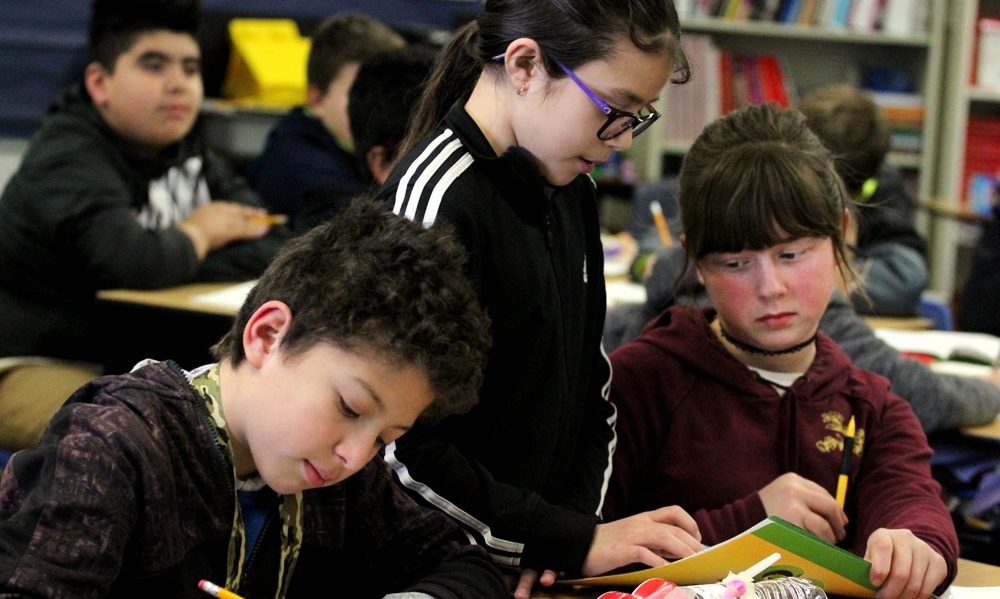
Alameda students learn to collaborate and work independently to solve problems during a math lesson. From left: Alex Leon works on an activity sheet, while Daniela Mendoza and Eron Findling help each other out on a problem during class. (The Enterprise/Kristine de Leon)
ONTARIO – Alameda Elementary School in Ontario is achieving the kind of student success that is driving top state officials in Salem to talk about transforming education.
Once considered among the worst schools in Oregon, Alameda’s students now are showing growth in learning at a rate that puts it among the state’s top achievers.
Other schools in Malheur County are doing well, but a close look at Alameda shows what it takes to change education.
It takes committed district executives and school leaders.
It takes determined teachers.
And it takes parents unwilling to give up on their local school.
Interviews with school officials and a detailed examination of state data show an emerging school.
“Ontario had a bad reputation for a while, as well as most other Malheur County schools,” said Ryan Roulston, president of the teachers union at Ontario School District. “There was a time when Ontario schools were seen as not as great, but that’s been changing over time.”
About 10 years ago, Ontario schools such as Alameda and May Roberts struggled to get their students proficient at their grade level. From 2010 to 2013, Alameda was designated a target school needing so much help that the state Education Department had to step in.
Andrea Buchholz, Alameda Elementary School principal, said Ontario schools have historically been viewed subpar compared to other schools in the county.
With an enrollment of about 400, Alameda serves a high-poverty population of students between kindergarten and sixth grades. Nine out of 10 students are eligible for free or reduced cost lunches. Hispanic students are roughly 60 percent of the enrollment.
“This is not just unique to Alameda,” Nicole Albisu, Ontario school superintendent, wrote in an email. “Our entire school district faces the same challenges related to poverty and language development.”
The Malheur Enterprise picked Alameda as one example of the district’s schools, spending time with teachers and staff, in classrooms and at the school.
Like most schools in Malheur County, Alameda and other schools in Ontario generally tested low in math and English in state tests.
But raw test scores don’t tell the whole story. While test scores tell whether students are at grade-level, they don’t show how much academic progress was made in the year up to the tests.
The data, based on the state Report Cards released in October, show that Alameda’s students are making above-average academic progress in both math and English.
The typical student at Alameda exhibited growth in math as high or higher than 68 percent of their academic peers. In English, a typical student’s level of academic growth was as high or higher than 64 percent of their peers across the state.
Alameda’s academic growth are on par or better than those of high performing elementary schools like Oak Creek Elementary in Lake Oswego or others in the Portland-Salem area.
However, Albisu points out that elementary schools in the Ontario District have “achieved similar results with only slight variances.”
“All elementary schools in the district have achieved similar results with only slight variances. That is a result of district-wide systems, initiatives, and professional development are consistent across all schools,” wrote Albisu. “As with every school in the district, our staff cares deeply about kids. We meet them where they are at emotionally, physically, mentally, and academically and help them grow from there.”
Where Alameda stands out is in sixth-grade math.
Student growth data from the Oregon education department show that during the 2017-18 school year, Alameda’s sixth graders had a growth score of 85. That means a typical sixth-grader at Alameda showed academic growth in math as high or higher than 85 percent of their academic peers across the state.
This might be due to the school’s efforts to provide students with more classes focusing on critical thinking and analytical skills.
Alameda recently revamped its school schedule to make more time for science, technology, engineering, art and math learning. Buchholz said that program is “built into every grade level.”
A typical school day ends with the STEAM period, when all 17 classrooms turn into bustling spaces. In one room recently, fifth-grade students were abuzz with excitement as they used the latest technology to solve problems. In another room, third-grade students were drawing and designing 3-D art.
Sixth-grader Alyvia Wilber students said it’s her favorite part of the day.
“You get to do a lot of activities together and not just sit down in your chair,” said Wilber.
She said, on any given day, her class might try experiments, make art, design and create robots, and try their hands at programming.
Most of all, Wilber said she likes her teachers.
Alameda sixth graders also improved significantly in English language arts, where student growth was in the top third in the state.
Other schools in the area, like Pioneer Elementary and May Roberts Elementary, showed marked student growth in the subject as well.
“We’re really methodical about our school schedule,” said Buchholz. “We’re also really super intentional about our interventions here at Alameda.”
Narrowing the gap
Over the last three years, Alameda has been making strides in closing the academic gap between Latino and white students.
The latest school report card showed Latino and white students achieving comparable levels of growth in math and in English. Notably, Latino students at Alameda are improving at a rate well above the state average.
It’s also worth noting that Alameda Elementary has high attendance rates – 93 percent of its students were regular attenders during the 2017-18 school year, above the state average at 80 percent.
Buchholz said the school focuses on the ways students with different economic and cultural backgrounds learn, which is done with the help of the school’s instructional coaches.
“They’re part of our teaching team,” said Buchholz. “They take responsibility for the kids they work with.”
Each school in the Ontario school district has at least one instructional coach to work with the students and teachers. At Alameda, an instructional coach helps 21 teachers in all facets of the classroom in subjects from music to math, working closely with students to provide academic counseling and behavioral support. In addition, the school has roughly 20 educational assistants that are classified staff distributed to classrooms with the most need.
“We’re constantly moving and changing our interventions,” said Buchholz. “Our coach is always right on it. We’re constantly looking at the data and moving kids where we need to.”
Alameda’s emphasis on data and performance tracking goes back to the mission and values laid out by the school district.
Albisu pointed out that all Ontario schools share “an unrelenting focus and review of individual student data” with “laser-like attention on standards and pacing through curriculum.”
“We really do try to dig in and do these things really well rather than looking for something new that will potentially fix the problem,” Albisu wrote.
This is apparent in the classroom, said Val Reynolds, an instructional coach at Alameda.
“You don’t walk into a lot of classrooms here where the teacher is up there giving the lecture and students are taking notes. That’s just not the way learning is now,” said Reynolds. “It’s a lot more discovery-based and collaborative learning amongst the peer groups and with the teacher as well.”
In this approach, Reynolds said, students tend to have more structural support and stay engaged in the classroom.
“We have a lot of incentives for kids to just do the right thing and yet strive to be competitive,” said Reynolds. “I think the school culture is when you can provide an environment where students feel safe, like they are part of the family. Because when kids feel safe, they can let go of worries and focus on learning.”
This is reflected in the student involvement and engagement in after-school programs.
Amber Campbell, a parent of a sixth-grader, said likes how the school fosters leadership in students through an after-school program.
Campbell’s daughter, Cayman, who is the president of the leadership club, said students learn to run the student store, where they do the inventory, accounting and sales.
“I’ve learned a lot about responsibility and lead. I think learning these skills in a way prepares us for middle school,” said Cayman Campbell. “It has taught me how to be a leader for younger students and be a role model on how to behave.”
With its driving focus on educating all students, initiatives like these, from leadership programs to community partnerships, Alameda continually looks for and provides opportunities for students to thrive.
And all of this is being accomplished in a town with plenty of its own challenges. Ontario has one of the highest poverty rates among cities in Oregon.
Under Buchholz’s leadership and with the help of her faculty, Alameda shows what a school can accomplish when it is committed to equity and to making new educational opportunities available to all children.
And with such diversity at the school, Alameda is a place for shared experiences, which helps students better understand one another.
“At the end of the day it really comes down to relationships … because you want to perform well for people who are invested in you,” said Buchholz. “Everybody wants the kids to do well, and our kids work really hard, too. Our kids understand why we’re doing what we’re doing.”
Reporter Kristine de Leon:[email protected] or 541-473-3377
TRY A FREE SAMPLE – You can see for yourself the kind of local news reporting produced by the Malheur Enterprise with a news team focused exclusively on news that’s important to you. You can read us for free for 30 days. Signing up is easy and then you have 24/7 access to our reports. Sign up HERE. Or you can support some of the nation’s best journalism by subscribing to our digital news service for $5 a month, easy and automatic. Subscribe HERE.




